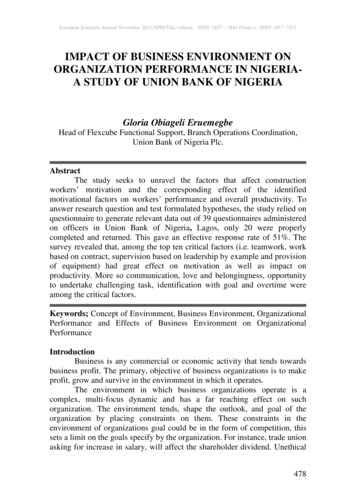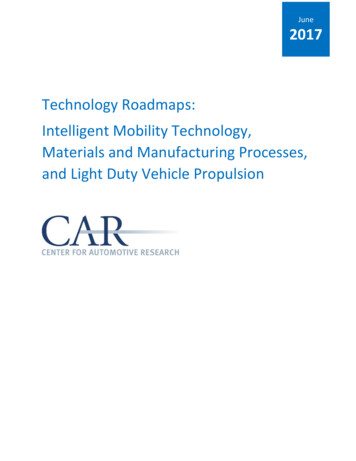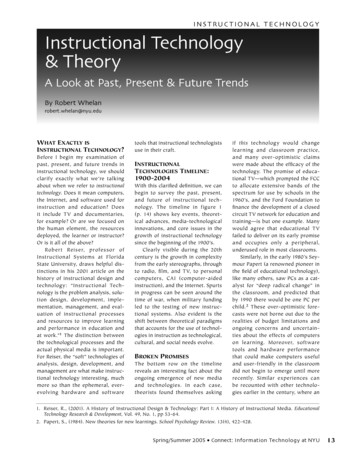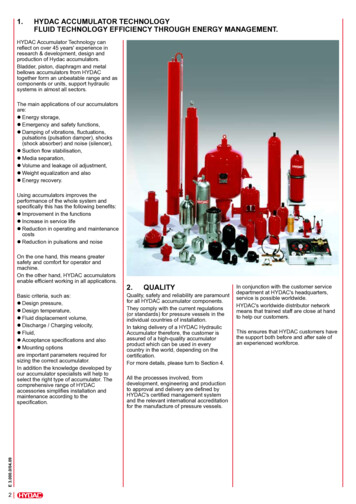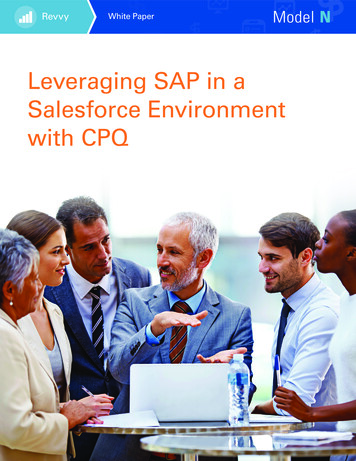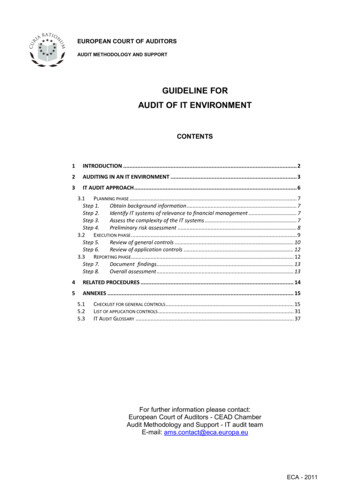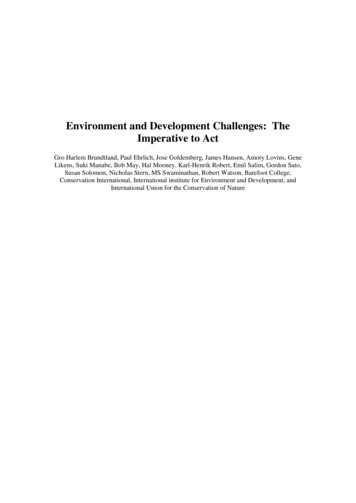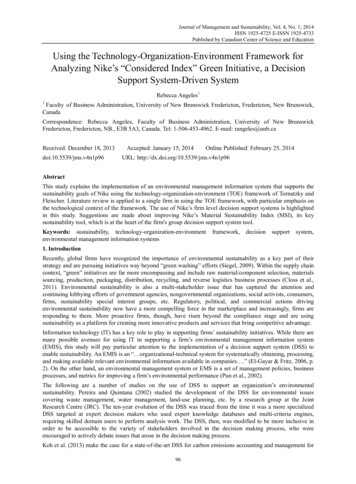
Transcription
Journal of Management and Sustainability; Vol. 4, No. 1; 2014ISSN 1925-4725 E-ISSN 1925-4733Published by Canadian Center of Science and EducationUsing the Technology-Organization-Environment Framework forAnalyzing Nike’s “Considered Index” Green Initiative, a DecisionSupport System-Driven SystemRebecca Angeles11Faculty of Business Administration, University of New Brunswick Fredericton, Fredericton, New Brunswick,CanadaCorrespondence: Rebecca Angeles, Faculty of Business Administration, University of New BrunswickFredericton, Fredericton, NB., E3B 5A3, Canada. Tel: 1-506-453-4962. E-mail: rangeles@unb.caReceived: December 18, 2013doi:10.5539/jms.v4n1p96Accepted: January 15, 2014Online Published: February 25, 2014URL: http://dx.doi.org/10.5539/jms.v4n1p96AbstractThis study explains the implementation of an environmental management information system that supports thesustainability goals of Nike using the technology-organization-environment (TOE) framework of Tornatzky andFleischer. Literature review is applied to a single firm in using the TOE framework, with particular emphasis onthe technological context of the framework. The use of Nike’s firm level decision support systems is highlightedin this study. Suggestions are made about improving Nike’s Material Sustainability Index (MSI), its keysustainability tool, which is at the heart of the firm's group decision support system tool.Keywords: sustainability, technology-organization-environmentenvironmental management information systemsframework,decisionsupport system,1. IntroductionRecently, global firms have recognized the importance of environmental sustainability as a key part of theirstrategy and are pursuing initiatives way beyond “green washing” efforts (Siegel, 2009). Within the supply chaincontext, “green” initiatives are far more encompassing and include raw material/component selection, materialssourcing, production, packaging, distribution, recycling, and reverse logistics business processes (Closs et al.,2011). Environmental sustainability is also a multi-stakeholder issue that has captured the attention andcontinuing lobbying efforts of government agencies, nongovernmental organizations, social activists, consumers,firms, sustainability special interest groups, etc. Regulatory, political, and commercial actions drivingenvironmental sustainability now have a more compelling force in the marketplace and increasingly, firms areresponding to them. More proactive firms, though, have risen beyond the compliance stage and are usingsustainability as a platform for creating more innovative products and services that bring competitive advantage.Information technology (IT) has a key role to play in supporting firms’ sustainability initiatives. While there aremany possible avenues for using IT in supporting a firm’s environmental management information system(EMIS), this study will pay particular attention to the implementation of a decision support system (DSS) toenable sustainability. An EMIS is an “ organizational-technical system for systematically obtaining, processing,and making available relevant environmental information available in companies .” (El-Gayar & Fritz, 2006, p.2). On the other hand, an environmental management system or EMS is a set of management policies, businessprocesses, and metrics for improving a firm’s environmental performance (Pun et al., 2002).The following are a number of studies on the use of DSS to support an organization’s environmentalsustainability. Pereira and Quintana (2002) studied the development of the DSS for environmental issuescovering waste management, water management, land-use planning, etc. by a research group at the JointResearch Centre (JRC). The ten-year evolution of the DSS was traced from the time it was a more specializedDSS targeted at expert decision makers who used expert knowledge databases and multi-criteria engines,requiring skilled domain users to perform analysis work. The DSS, then, was modified to be more inclusive inorder to be accessible to the variety of stakeholders involved in the decision making process, who wereencouraged to actively debate issues that arose in the decision making process.Koh et al. (2013) make the case for a state-of-the-art DSS for carbon emissions accounting and management for96
www.ccsenet.org/jmsJournal of Management and SustainabilityVol. 4, No. 1; 2014product supply chains which would be inclusive of both the firm of focus and its supply chain trading partners.The system has an interorganizational orientation in approaching the decision making process involved inreducing carbon emissions along the entire supply chain, using the hybrid life cycle analysis method in assessingdirect and indirect carbon emissions in key business processes. This supply chain environmental analysis tool(SCEnAT) was developed using supply chain (SC) mapping, SC carbon accounting, SC interventions, and SCintervention evaluations on a range of key performance indicators. Finally, the authors narrate how the SCEnATsystem was tested in a specific setting.Foxon, et al. (2013) studied the implementation of the Sustainable Water Industry Asset Resource DecisionsProject, which adopted a multi-criteria analysis DSS to support water providers in the UK in assessing thesustainability of the water/wastewater system asset development decisions. The set of sustainability criteriaembedded in this system was developed and tested with project partners in the UK and Romania.This study looks at how Nike, a premier sports shoe and apparel firm, implemented its EMIS in the form of aDSS to enable its “Considered Index” environmental sustainability initiative and as a component of its EMS. Thetheoretical framework used for understanding how Nike deployed its DSS oriented EMIS is Tornatzky andFleischer’s (1990) technology-organization-environment framework.2. Research QuestionThis study seeks to answer this research question: “How can we explain the implementation of an EMIS,specifically, a DSS focused on supporting environmental and sustainability goals of Nike using the TOEframework?”3. Literature Review on the Technology-Organization-Environment (TOE) FrameworkThis study will use the technology-organization-environment (TOE) framework introduced by Tornatzky andFleischer (1990) that uses three elements that influence technological adoption—the environmental context, theorganization context, and the technological context.3.1 Environmental ContextThe environmental context is the arena surrounding a firm, consisting of multiple stakeholders such as industrymembers, competitors, suppliers, customers, the government, the community, etc. They can influence how a firminterprets the need for innovation, its ability to acquire the resources for pursuing innovation, and its capabilityfor actually deploying it. These stakeholders could either support or block technological innovation.Changing market and competitive conditions prod firms to use various forms of innovation. Governmentregulation is also another powerful tool for constraining a firm’s operational activities, increasing costs ofproduction, and instigating an investigation of technologies that must meet specified criteria. Finally, dominantcustomer firms could exert their power to shift their suppliers’ production activities to comply with itsrequirements.3.2 Organizational ContextA range of descriptive measures characterize the “organizational context”: firm size; the centralization,formalization, and complexity of its managerial structure; the quality of its human resources; the amount of slackresources available internally; formal and informal linkages within and outside the firm; decision making andinternal communication methods; and boundary spanning mechanisms to communicate with the externalenvironment. “Organic” and “mechanistic” organizational systems are also relevant here (Burns & Stalker, 1961).Frequent lateral communication, decentralization of leadership and control, and active networking both withinand outside the firm are hallmarks of the “organic” system. Building interorganizational collaborationmechanisms is fundamental in meeting the needs of electronic coordination linkages enabling supply chainpartnerships.Top executives can energize major organizational changes by (Tushman & Nadler, 1986): (1) communicating aclear image of the firm’s strategy, core values, and role of technology in meeting this strategy; (2) sendingconsistent signals within and outside the firm about the value of the innovation; and (3) creating a teamresponsible for crafting a vision relevant to the innovation.3.3 Technological ContextThe TOE framework suggests a method of implementing a technology innovation which will be referenced inthe analysis of the deployment of the sustainability initiative by 7G. The following steps described belowcomprise the ”systems design” perspective depicted by Tornatzky and Fleischer (1990), which incorporates thebest aspects of the following methods used in implementing technology solutions : technocentric, sociocentric,97
www.ccsenet.org/jmsJournal of Management and SustainabilityVol. 4, No. 1; 2014conflict/bargaining, systems life cycle, and socio-technical systems approaches. Different aspects of theseapproaches could be more prominent in the one or more steps discussed below.The technocentric approach was derived primarily from industrial engineering and its key distinguishing featureis its exclusive focus on the hardware components and embedded knowledge domains to the exclusion of social,human end user needs and issues (Lawson et al., 1983; Gunn, 1982).In direct contrast, the sociocentric approach focuses on the organizational and social setting of the IT innovation,with its origins from organizational sociology (Perrow, 1972; Hall, 1982), organizational behavior (Lawrence &Lorsch, 1967), and communications (Rogers, 1983). The sociocentric approach espouses the followingimplementation activities: (1) measure the innovation’s effectiveness in terms of the social system’s socialfunctioning; (2) consider the social and organizational issues when planning and pacing the implementation ofthe innovation; (3) allow for flexibility in the organizational design while keeping coordination andorganizational purpose; and (4) support the innovation implementation with appropriate human resourcedevelopment practices (Tornatzky & Fleischer, 1990).The conflict/bargaining perspective recognizes that decisions involving initiatives that include multiple partieswill be challenged by their clashing interests (Elmore, 1978; Pressman & Wildavsky, 1973). Thus, theimplementation initiative should embrace all affected stakeholders and promote practices and processes thatencourage cooperation and collaboration to resolve their differences.The systems life cycle approach, also commonly referred to as the SDLC, is a methodology used to develop ISsolutions (Clarke, 1987; Pressman, 1987). SDLC encompasses the following phases: (1) systems planning andselection (i.e., identification, planning, and selection of a development project based on priorities); (2) systemsanalysis (i.e., gaining a thorough understanding of the current business processes surrounding the problem areaof the project); (3) systems design (i.e., identification of the specifications of the design solution); (4) systemsimplementation and operation (i.e., transforming the IS design solution into a operational working version); and(5) systems maintenance (i.e., the repair, improvement, and updating of the operational system solution)(Valacich & Schneider, 2012).The socio-technical approach (STS) has its beginnings from both organization change practice (Trist & Bamforth,1951) and social psychology (Katz & Kahn, 1978). It seeks the resolution of the main concerns of the socialsystem (i.e., organizational design, reward systems, communication patterns) and the technical system (i.e.,process, technology, tools, machines, and methods) in pursuing the implementation of an IT innovation in anorganization (Tornatzky & Fleischer, 1990).Tornatzky and Fleischer (1990) presented their “systems design perspective,” which is a synthesis of thefollowing approaches: technocentric, sociocentric, conflic/bargaining, systems life cycle, and socio-technicalsystems.(1) Understand the characteristics of the innovationThe technocentric approach espouses the notion that technological factors dominate the implementationexperience, thus, leading to the following consequences: (a) there should be a detailed technical plan forimplementation; (b) methods engineering should help in the redesign of business processes and jobs; (c) theinnovation should be able to be integrated with the existing technical system; and (d) technical criteria should beused in measuring implementation effectiveness (Rousseau, 1988). The “systems design perspective” also callsfor a technology-organization match. The technology innovation also influences how different parts of a firmneed to coordinate. Implementation of information systems supporting environmental goals extends the level ofcoordination needed from internal integration to interorganizational integration within the supply chain context.(2) Develop measures of implementation effectivenessA wholistic approach to measuring implementation effectiveness would include metrics that are relevant to thetechnocentric, systems development life cycle, sociocentric, and conflict/bargaining approaches.(3) Plan and pace implementationPacing technology implementation refers to the speed at which changes are unfolded, which could rangeanywhere from gradual to radical (Roitman et al., 1987).(4) Design or redesign the organizationThe sociocentric approach focuses on making the organization more flexible, humanistic, and open to changesbrought about by the innovation (Tornatzky & Fleischer, 1990).98
www.ccsenet.org/jmsJournal of Management and SustainabilityVol. 4, No. 1; 2014(5) Modify human resources policie
Journal of Management and Sustainability; Vol. 4, No. 1; 2014 ISSN 1925-4725 E-ISSN 1925-4733 Published by Canadian Center of Science and Education 96 Using the Technology-Organization-Environment Framework for Analyzing Nike’s “Considered Index” Green Initiative, a Decision Support System-Driven System Rebecca Angeles1 1 Faculty of Business Administration, University of New
